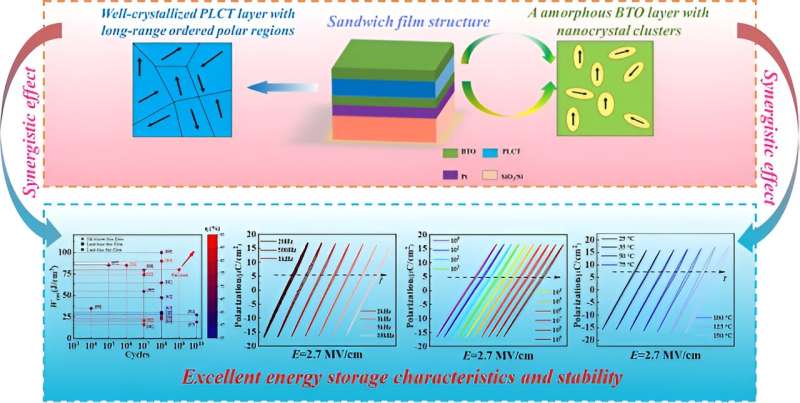
As a green, sustainable, and competitive technology relative to batteries and electrochemical capacitors and featuring a high charge storage capability, the dielectric capacitors excel in low cost, long cycle-life, and a broad operating temperature range, as well as environmental friendliness, high security, and good reliability.
Most importantly, they top other technologies in terms of ultra-high-power density due to their unrivaled charge-discharge speed. These features have created a number of applications for them in power electronic devices and pulsed power equipment. Among the dielectric capacitors, the ferroelectric ones can provide a high energy density due to large electric polarization, thereby receiving an increasing amount of great attention.
Recently, a team of material scientists led by Jun Ouyang and Hanfei Zhu from Qilu University of Technology in Jinan, China reported an effective strategy that aimed to achieve synchronous improvements in energy storage density, efficiency, and stability of ferroelectric capacitors by constructing a simple tri-layer film heterostructure in which a well-crystallized ferroelectric layer was sandwiched by two pseudo-linear dielectric layers with a dominant amorphous microstructure, which can become a generally effective pathway to enhance the energy storage performances of ferroelectrics capacitors working in various harsh environments.
The team published their work in the Journal of Advanced Ceramics.
"In this report, we propose a strategy to boost the energy storage performances and stabilities of ferroelectric capacitors simultaneously by constructing a tri-layer film in which a well-crystallized ferroelectric layer was sandwiched by two pseudo-linear dielectric layers with a dominant amorphous structure."
"We successfully implemented this design strategy in the sol-gel-derived BaTiO3/(Pb,La,Ca)TiO3/BaTiO3 tri-layer films via rapid thermal annealing. This sandwiched film is endowed with a large energy density Wrec (~80 J/cm3) and a high efficiencyh (~86%), especially an outstanding cycling stability that can withstand 109 electric cycles."
"This innovative work will pave the way for the utilization of sandwiched ferroelectric films in applications of electric power systems and advanced pulsed-discharge devices," said Hanfei Zhu, an associate professor at the School of Chemistry and Chemical Engineering at Qilu University of Technology (China), and one young expert whose research interests focus on the field of ferroelectric and multiferroic materials.
"In contrast to the electrochemical energy-storage systems, the low energy density of dielectric capacitors is a fatal application bottleneck, especially in miniaturized devices and integrated systems," Hanfei Zhu said.
Due to their large electric polarizations, the ferroelectric film capacitors have shown great potential in providing a high energy density. Nevertheless, a trade-off, usually a negative correlation, between the polarization (P) and the breakdown strength (Eb) and the more easily produced loss of ferroelectric films severely limit the further increase in energy density and efficiency.
Beyond that, the film capacitors are vulnerable to potential damages caused by the changes in circuit temperature, working frequency, and load rate. "So how to break or mitigate the couplings between polarization, breakdown strength, and loss by efforts so as to improve the energy storage performances and the stabilities in a broad temperature, frequency, and cycling time has become a challenge for the ferroelectric film capacitors," said Hanfei Zhu.
To address these above issues, Zhu's team proposed an effective strategy that aimed to achieve synchronous improvements in energy storage density, efficiency, and stability of ferroelectric film capacitors by constructing a simple tri-layer film structure in which a well-crystallized ferroelectric layer was sandwiched by two pseudo-linear dielectric layers with a dominant amorphous microstructure.
The research team provided a paradigm of sandwich BaTiO3/(Pb,La,Ca)TiO3/BaTiO3 thin film fabricated on Pt-coated Si substrate via a low-cost sol-gel method combining with a rapid thermal annealing (RTA) process.
The fully crystallized PLCT layer in sandwich film and the amorphous BTO layer with some independently distributed nanocrystal clusters (NCs) work together to create a large energy density Wrec (~80 J/cm3) and a high efficiency h (~86%), especially its much-improved energy storage stabilities against a varying temperature (25–150 ℃), frequency (20 Hz–10 kHz) and charge-discharge cycle (up to 109 cycles).
"Our work shows that the sandwich thin films by co-designing nanocrystal-dispersed amorphous and fully-crystallized phase structures can become a generally effective pathway to enhance the energy storage performances of ferroelectrics capacitors working in harsh environments," Hanfei Zhu said.
More information: Jinpeng Liu et al, Synergically improved energy storage performance and stability in sol–gel processed BaTiO3/(Pb,La,Ca)TiO3/BaTiO3 tri-layer films with a crystalline engineered sandwich structure, Journal of Advanced Ceramics (2023). DOI: 10.26599/JAC.2023.9220821
Provided by Tsinghua University Press
Citation: Synergically improved energy storage performance and stability in tri-layer films with crystalline sandwich structures (2024, March 29) retrieved 29 March 2024 from https://techxplore.com/news/2024-03-synergically-energy-storage-stability-tri.html
This document is subject to copyright. Apart from any fair dealing for the purpose of private study or research, no part may be reproduced without the written permission. The content is provided for information purposes only.
